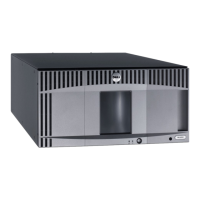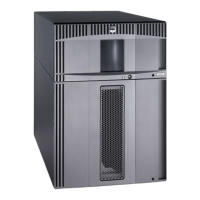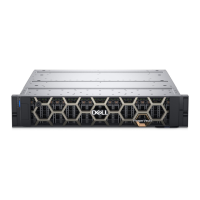Troubleshooting
file:///T|/htdocs/stor-sys/ML6000/en/html/ch09.htm[9/17/2012 1:50:53 PM]
cabling the library or troubleshooting the library control paths of tape drives. The green LED blinks 10 times per
second for one minute.
On the Web client Identify Drives screen, you can identify the tape drives assigned to a particular partition, all unassigned
tape drives, and the control path tape drive for each partition by flashing the green LEDs on the back of tape drives that are
in a ready state:
• Use the Identify All button to flash the LEDs on the back of the selected tape drives. Only tape drives in a ready
state will flash. If you have selected a specific partition or have only one partition configured, all the green LEDs on the
tape drives within the partition will blink. If you have selected Unassigned, all the green LEDs on the unassigned tape
drives will blink. If you have selected All, the green LEDs on all tape drives installed in the library will blink.
• Click Identify Control Path to flash the green LEDs on the back of the one or more control path tape drives. Only
tape drives in a ready state will flash. The control path tape drive is used to connect each partition to the host
application. Use this button when you are cabling the library or troubleshooting the library control paths of tape drives.
If you have selected a partition, the green LED on the partition's control path tape drive will blink. If you have selected
All, the green LEDs on all the ready control path tape drives will blink.
Note: There is no control path tape drive for a partition that uses FC I/O blades to connect tape drives to a host
application.
The paths to open the appropriate screens are as follows:
•
From the Web client, select Tools > Identify Drives
.
•
From the operator panel, select Tools > Drive Info
.
Retrieving Tape Drive Logs
Administrators can use the Web client to retrieve tape drive logs. Tape drive log information can be used to help troubleshoot
library and tape drive issues. You can use the Retrieve Drive Log screen to select the appropriate tape drive.
Note: Bold column headings in the table can be sorted. For example, selecting the Location column heading will sort
by location coordinates.
Details on retrieving tape drive log files include:
• Since the log retrieval process can take up to 30 minutes, the tape drive and associated partition are automatically
taken offline during the operation and brought back online when the operation completes. You will be asked to confirm
that you want to take the tape drive and partition offline.
• Tape drive logs adhere to the following naming convention: UDS_ID_SN.dmp, where ID identifies the tape drive
coordinate location within the library and SN identifies the tape drive serial number.
• You can select the interface type (SCSI, SAS, or FC) of the tape drive from which you want to retrieve logs.
For more detailed, step-by-step instructions, see your library's online Help. To access the online Help system, click the Help
icon at the top right of the Web client or operator panel user interface.
You cannot retrieve tape drive logs from the operator panel. The path to open the appropriate screen is as follows:
•
From the Web client, select Tools > Drive Operations.
Retrieving Tape Drive Sled Logs
Administrators can retrieve tape drive sled logs. Tape drive sled log information can be used to help troubleshoot library, tape
drive sled, and tape drive issues. You can use the Retrieve Drive Sled Log screen to select the appropriate tape drive sled.
Note: Bold column headings in the table can be sorted. For example, selecting the Location column heading will sort
by location coordinates.
Details on retrieving tape drive sled log files include:
• Tape drive sled logs adhere to the following naming convention: UDS_ID_SN.LOG, where ID identifies the tape drive
sled coordinate location within the library and SN identifies the tape drive sled serial number.
• You can select the interface type (SCSI, SAS, or FC) of the tape drive sled from which you want to retrieve logs.

